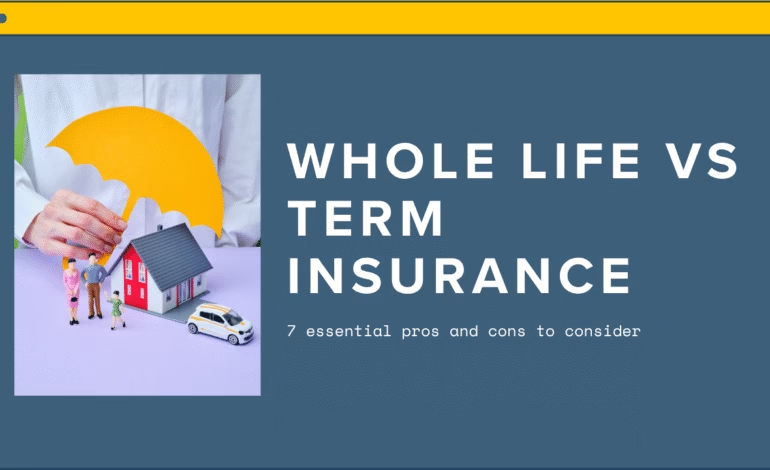
Why Choosing the Right Life Insurance Matters
Imagine this. You are sitting with a financial advisor who asks you a simple question: “Do you want coverage for a fixed term or for your entire life?” You nod, unsure. Somewhere in your mind, you know that term life insurance is cheaper, but whole life insurance builds cash value. Then the confusion begins. Which one should you choose?
This is one of the most common dilemmas people face while planning their financial security. Picking between term and whole life insurance can shape your long-term financial health, your tax benefits, and even the legacy you leave behind.
In this article, we are going to break down the whole life vs term insurance pros and cons in a way that is clear, engaging, and 100 percent practical. You will learn not only what each policy offers but also how real people use them. Whether you are in the US, UK, Canada, Singapore, or Australia, this guide will help you make a confident, informed choice that aligns with your goals.
Before diving deep, let’s clarify the basics.
What Is Term Life Insurance?
Term life insurance is simple to understand. You pay a fixed premium for a set number of years, say 10, 20, or 30 years. If you pass away during that period, your beneficiary receives the death benefit. If you survive the term, the policy expires and no money is paid out.
It is like renting insurance protection for a period of time. You get high coverage for a low premium. For example, a healthy 30-year-old male in the US could buy a $500,000 term policy for around $25 a month.
This affordability is what makes term life insurance the most popular choice among young families and working professionals who want financial protection without locking away too much money.
What Is Whole Life Insurance?
Whole life insurance, on the other hand, is more like owning a house instead of renting one. It covers you for your entire lifetime, as long as you keep paying the premiums. Plus, it includes a savings or investment component known as cash value that grows over time.
A portion of every premium goes into this cash value, which you can borrow against, withdraw, or even use to pay future premiums. It sounds attractive, right? But it also comes at a higher cost.
For example, the same 30-year-old male buying a $500,000 whole life policy might pay around $400 to $500 per month. That’s nearly 20 times more than a term plan.
So, which one is right for you? Let’s look at the term life versus whole life comparison from every angle.
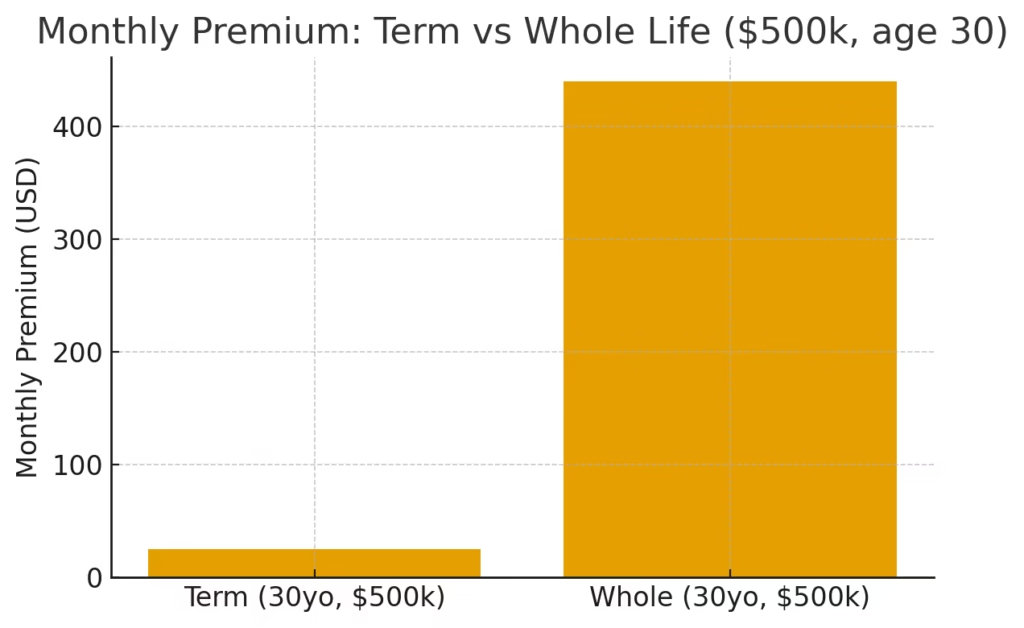
According to Policygenius, term life insurance remains the most cost-effective choice for young earners looking for maximum coverage at affordable premiums.
Before finalizing your decision, you might also like Life Insurance vs Term Insurance: Smartest Way to Secure Your Future in 2026 for an in-depth comparison of coverage options and benefits.
Understanding the Core Difference
To simplify it:
- Term life = pure protection for a limited time
- Whole life = lifelong protection plus cash value savings
But the implications of this difference are much deeper.
With term insurance, you are betting that you may not need lifelong coverage. It’s about protection for your working years when your income matters most. With whole life, you are investing in guaranteed lifelong security and potential wealth accumulation.
Here’s a quick real-world example.
Let’s say Sarah, a 35-year-old single mom in Canada, chooses term life insurance because her main goal is to ensure her children’s education is covered if something happens to her before they are independent. On the other hand, Mark, a 45-year-old business owner in Australia, prefers whole life insurance because he wants to build a tax-efficient asset that he can pass on to his heirs.
Both made smart choices but for different reasons.
Whole Life vs Term Insurance Pros and Cons: The Real Picture
Let’s break down both sides clearly.
Pros of Term Life Insurance
- Affordability: Term insurance offers maximum coverage at minimal cost. This allows you to allocate more money toward investments or savings.
- Simplicity: There are no investment risks or complex terms. You pay premiums and get coverage. That’s it.
- Flexibility: You can choose the term length based on life milestones such as 20 years until kids graduate or 30 years until retirement.
- Convertibility Options: Some term policies can be converted into whole life policies later without a medical exam.
Cons of Term Life Insurance
- No Cash Value: The biggest drawback is that if you outlive your policy, you get nothing back.
- Premiums Rise with Age: Renewing a term policy later in life can become expensive.
- Limited Coverage Period: Once the term ends, you are uninsured unless you buy a new plan.
Now, let’s flip the coin.
Pros of Whole Life Insurance
- Lifetime Coverage: It never expires as long as you pay premiums.
- Builds Cash Value: You accumulate money that grows tax-deferred and can be borrowed or withdrawn.
- Predictable Premiums: Premiums remain fixed, even as you age.
- Estate Planning Benefits: Ideal for transferring wealth to heirs without estate tax complications.
Cons of Whole Life Insurance
- High Cost: Premiums are much higher than term policies, often making it unaffordable for younger families.
- Lower Returns: Cash value growth is typically slow and conservative compared to market investments.
- Complexity: It requires understanding investment performance, surrender values, and policy loans.
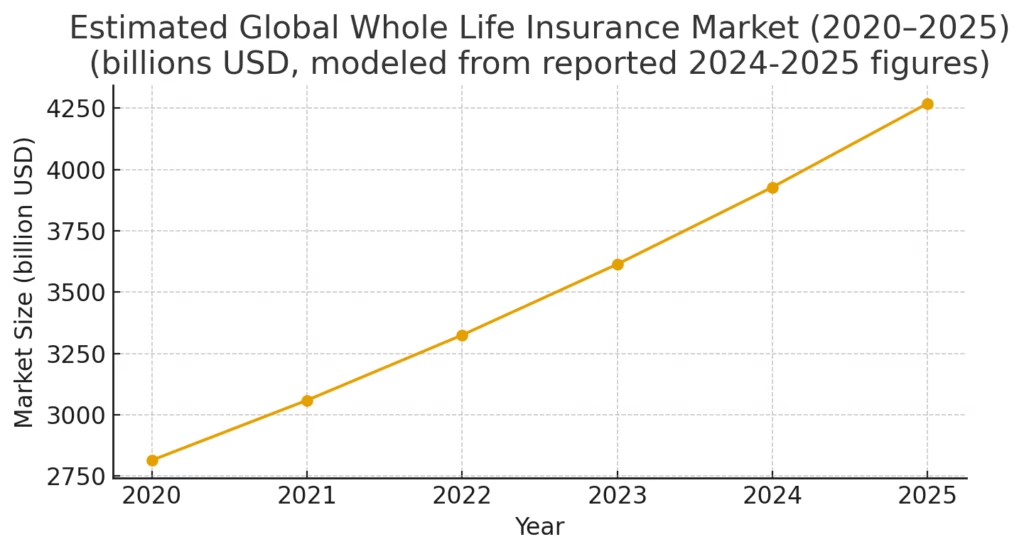
The Psychology Behind the Choice
Here is a small thought exercise for you.
Ask yourself: “Do I see life insurance as protection or as an investment?”
If your answer is protection, term life fits best. If it’s both protection and long-term wealth building, whole life may appeal more.
In fact, financial planners often say the best choice depends on your phase of life and your financial responsibilities.
For instance, young earners in the UK who want maximum coverage at a lower cost typically go for term life. But retirees or high-net-worth individuals in Singapore often prefer whole life because they value stability and tax efficiency over affordability.
Quiz Time: Test Your Knowledge
Here’s a quick quiz you can drop your answer in the comment section to engage with other readers:
Question: If you are 30 years old with two kids and a mortgage, which insurance makes more sense for you today term life or whole life?
My Answer: Term life, because it gives high coverage during your income-generating years and keeps premiums manageable. You can later upgrade or supplement with a whole life plan when your income grows.
Term vs Whole Life Insurance Benefits Explained
By now, you have a good idea of how term and whole life insurance work. But understanding their real-world benefits and not just on paper is what helps you make the right decision. So let’s go a layer deeper into the term life versus whole life comparison that most advisors rarely explain clearly.
The Real Benefits of Term Life Insurance
1. Maximum Protection per Dollar
Term life gives you the highest death benefit for the lowest premium. It’s designed purely for protection. Let’s say you’re a 30-year-old in the US earning $60,000 per year. You could easily buy a $1 million term policy for less than $40 a month. That means your loved ones would be financially safe if something happens to you, and you still have most of your income free for saving or investing elsewhere.
This is why financial experts like Dave Ramsey and many certified financial planners emphasize term life as the foundation of financial safety. It’s lean, transparent, and efficient.
2. Freedom to Invest the Difference
The money you save from lower premiums can be invested in higher-return options like index funds, ETFs, or real estate. Over time, these can outperform the slow cash value growth of a whole life policy.
Here’s a quick math snapshot.
- Term policy: $30/month
- Whole life policy: $400/month
If you invest that $370 difference each month into an index fund returning 7 percent annually, you could build nearly $450,000 in 30 years, far exceeding the cash value from a whole life plan.
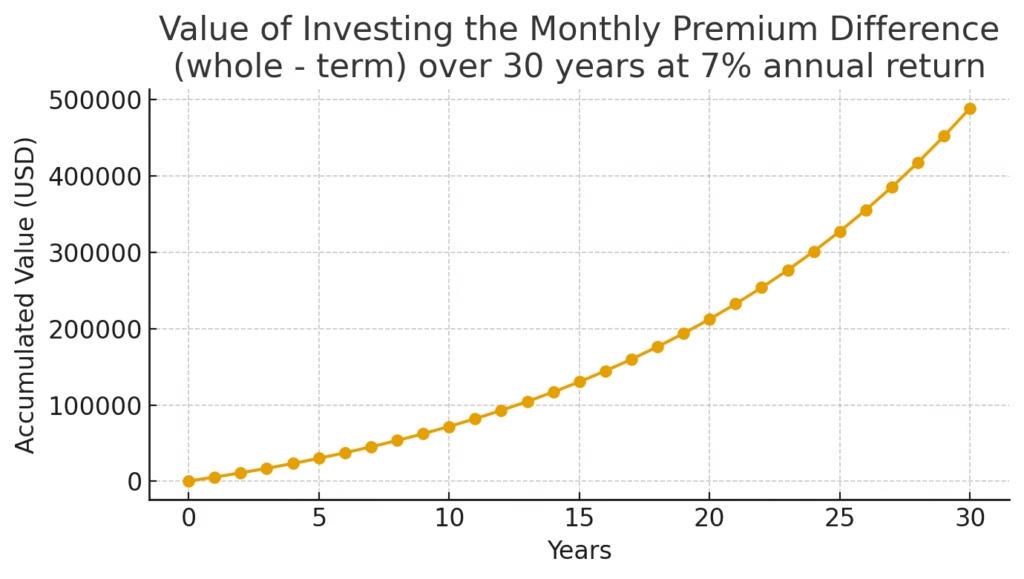
3. Short-Term Commitments Fit Modern Lifestyles
We live in a world where job changes, relocations, and lifestyle shifts happen often. A 20-year term policy fits this flexibility. Once your big responsibilities (like a mortgage or children’s education) are done, you might not need coverage anymore.
4. Convertible Options Add Flexibility
Some term policies allow you to convert to a whole life policy later, even if your health declines. That means you can start with affordable coverage now and move toward permanent protection later in life without new medical exams.
If you’re exploring broader financial planning, check out our detailed post on 10 Proven Strategies to Build Wealth in Your 30s, it’s a perfect complement to understanding how insurance fits into long-term wealth creation.
The Real Benefits of Whole Life Insurance
Whole life insurance is often misunderstood. Many people dismiss it because of the higher cost, but its long-term benefits can be powerful when used strategically.
1. Lifelong Security
Unlike term life, this policy never expires as long as you pay premiums. That means your family will receive a payout no matter when you pass away. This is valuable if you want to leave an inheritance or cover estate taxes.
2. Guaranteed Cash Value Growth
Every whole life policy builds cash value. This is like a built-in savings account that grows tax-deferred. You can borrow against it or even withdraw money in emergencies. Some people use this feature to fund their child’s college tuition or to supplement retirement income.
3. Stable Premiums That Never Increase
Unlike term policies that get more expensive when renewed, whole life premiums remain constant throughout your life. This stability can help with long-term budgeting, especially for high-income professionals who want predictability.
4. Policy Loans and Dividends
Many whole life policies, especially from reputable mutual insurers like Northwestern Mutual or MassMutual, pay annual dividends. These dividends can be used to reduce premiums, buy more coverage, or simply taken as cash. You can also take loans against your cash value without triggering taxes.
5. Estate and Tax Benefits
For people in countries like the US, UK, or Canada with estate or inheritance tax, whole life insurance plays a major role in tax planning. The death benefit is generally tax-free for beneficiaries, and the policy’s cash value grows without annual taxation.
Comparing Whole Life vs Term Life: Who Wins in Different Life Stages
Let’s break this down by age and financial goals to make it practical.
Early Career (Ages 25-35)
At this stage, affordability and high coverage matter most. Term life wins easily because it gives strong financial protection without straining your budget. You can start investing the savings elsewhere for long-term growth.
Family Building Stage (Ages 35-50)
As responsibilities grow with kids, loans, and aging parents, term life continues to offer the best coverage to cost ratio. However, adding a small whole life policy here can be a smart move for long-term wealth transfer or as part of estate planning.
Peak Career and Pre-Retirement (Ages 50-65)
Now you might have paid off debts and built savings. Whole life insurance can serve as a stable, tax-advantaged asset. Many use it to diversify their retirement portfolio or to leave a tax-free inheritance.
Retirement and Legacy Years (65+)
At this point, term life might no longer be available or affordable. Whole life insurance shines here because it ensures your family receives a payout regardless of when you pass away. It also provides liquidity for final expenses or estate taxes.
The Emotional Side of the Decision
Money aside, insurance decisions are often emotional. It’s about peace of mind. The idea that your family will be okay even if you are not around brings powerful emotional security.
Let’s take a relatable scenario.
John, a 38-year-old father in the UK, lost his job during a recession. Because he had opted for an expensive whole life policy years ago, the high premium became a burden. He eventually switched to a term plan, saving hundreds monthly, and reinvested the difference in a retirement fund.
Meanwhile, Emily, a 50-year-old entrepreneur in the US, used her whole life policy’s cash value to help her daughter start a business. The policy acted like a personal safety net, offering both liquidity and coverage.
The moral is simple: your insurance choice should reflect your lifestyle, not someone else’s advice.
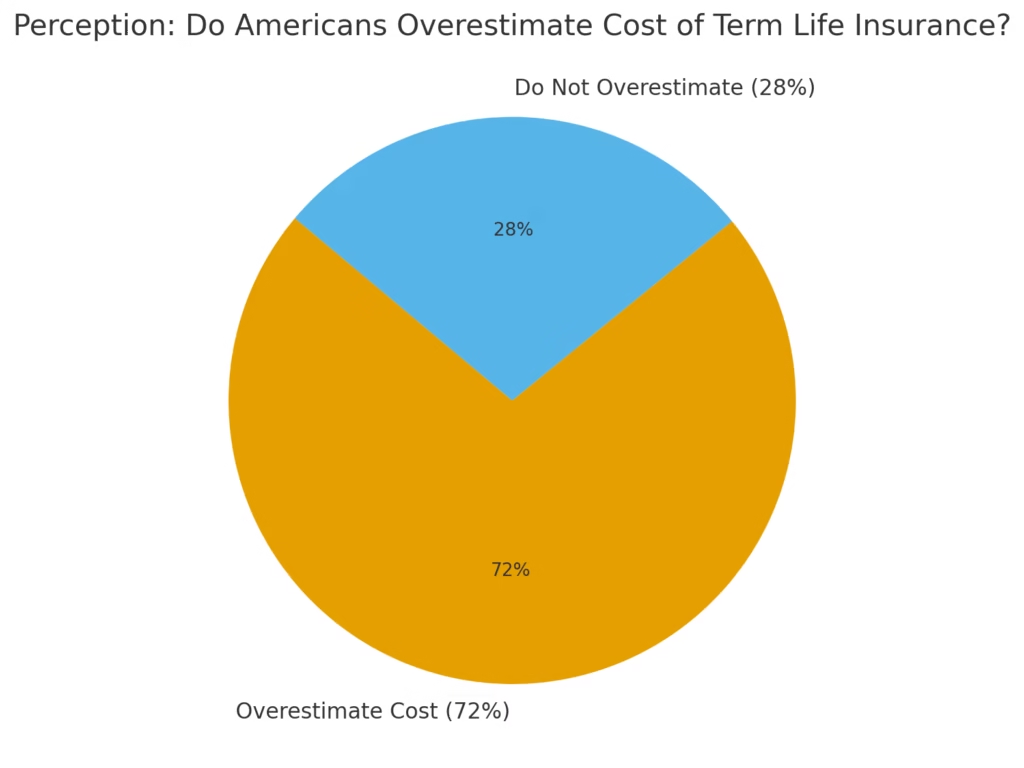
Common Myths About Term and Whole Life Insurance
Let’s clear the fog on a few widespread misconceptions.
Myth 1: Term life is always better
Not true. It depends on your goals. If you value guaranteed lifelong coverage and legacy planning, whole life can be worth the cost.
Myth 2: Whole life insurance is just an expensive savings plan
Partially true, but that’s not the full story. The guaranteed cash value, tax-deferred growth, and ability to borrow tax-free make it a unique hybrid of insurance and investment.
Myth 3: Once you buy a policy, you’re stuck forever
No. You can often convert, supplement, or ladder your insurance coverage based on changing needs. A good financial planner can help structure this flexibility.
Myth 4: You can’t mix both
Actually, many financially savvy people hold both. They buy term insurance for big responsibilities and a smaller whole life policy for lifelong benefits. This combination offers the best of both worlds.
Expert Insight: How the Wealthy Use Whole Life Insurance
In many developed countries, high-net-worth individuals and business owners use whole life insurance not just for protection but for wealth building and tax planning.
They treat it as a private bank, borrowing against the cash value at low interest while keeping the policy’s value growing. This strategy, often called the Infinite Banking Concept, allows them to access liquidity without selling investments or triggering capital gains taxes.
Of course, this approach requires careful planning and understanding of policy terms. It’s not for everyone, but it highlights how flexible whole life insurance can be when used strategically.
Real-Life Quiz
Scenario:
Imagine you’re a 40-year-old with kids in high school and a mortgage that will be paid off in 15 years. You also want to leave behind a small inheritance.
Question: Would you pick term life or whole life?
My Answer: A combination of both could work best. A term plan covers your immediate responsibilities like mortgage and income replacement, while a smaller whole life policy ensures a legacy and long-term stability.
Choosing Between Whole Life and Term Insurance: The Smart Way
Now that you know the whole life vs term insurance pros and cons, it’s time to bring it all together. Understanding both plans in theory is one thing, but deciding which one fits you is where clarity matters most.
Step 1: Define Your Purpose
Ask yourself this simple question: What am I really buying insurance for?
If your answer sounds like “to protect my family’s income if something happens to me,” then term life insurance likely fits your needs. It’s straightforward, affordable, and gives you the freedom to invest elsewhere.
But if your purpose is “to build a long-term, tax-efficient asset that lasts a lifetime,” then whole life insurance offers exactly that. It’s not just about death protection but about living benefits including cash value, borrowing potential, and estate planning advantages.
Tip: Start by writing down your top three priorities. Protection, savings, or legacy? Once that’s clear, your choice becomes obvious.
Step 2: Know Your Financial Personality
Some people are risk-takers who enjoy managing investments. Others prefer guaranteed, predictable growth. Which one are you?
If you’re the analytical type who tracks investments and market returns, a term policy combined with disciplined investing may give you the best results. You’ll maximize flexibility and potential returns.
If you’re the cautious type who prefers guarantees and dislikes volatility, a whole life policy may suit your peace of mind better. The fixed premiums and steady cash value growth act as a stabilizer in your long-term financial plan.
Real financial success happens when your insurance strategy matches your psychology, not just your numbers.
Step 3: Calculate the True Cost of Waiting
Every year you delay buying insurance, the premium rises because age and health risks increase.
Let’s look at an example.
Michael, a 30-year-old in the US, buys a 30-year term policy for $25 a month. His friend James waits until age 40. For the same coverage, James now pays $60 a month which is more than double.
Similarly, for whole life insurance, locking in a younger age brings massive long-term savings. Insurers love predictability, and youth gives you that edge.
If you’re still debating, it’s better to start small now than to overthink and lose the advantage of time.
Step 4: The Combo Strategy That Wins Both Ways
There’s a powerful approach used by many financial planners known as the blended strategy combining both term and whole life coverage.
Here’s how it works:
Buy a high-value term plan for your short-term protection (20 or 30 years) and a smaller whole life policy for lifelong security.
Example:
- Term Policy: $750,000 coverage for 25 years
- Whole Life Policy: $150,000 coverage for life
This way, you cover your family’s needs during your most financially active years while also building an asset that lasts forever. As your income grows, you can increase the whole life coverage or invest in separate instruments.
This hybrid approach balances affordability with permanence.
Step 5: Evaluate Using the 3 Cs Framework
A practical way to finalize your decision is through the 3 Cs: Cost, Commitment, and Control.
Cost: Term life costs less upfront, freeing money for investments. Whole life costs more but offers lifetime benefits and savings.
Commitment: Term life is flexible; you can stop when your needs change. Whole life requires long-term commitment to get full value.
Control: Term life gives you control to invest elsewhere. Whole life gives the insurer control over how your money grows, but it ensures safety and tax advantages.
When you score these based on your preferences, you’ll know instantly where you belong.
Advantages and Disadvantages of Whole Life Insurance in Modern Planning
Since this is one of major things need to check, let’s look closely at the advantages and disadvantages of whole life insurance in the context of today’s economy.
Advantages:
- Provides lifelong coverage, ensuring your loved ones always receive benefits.
- Builds guaranteed cash value that grows without market risk.
- Offers tax-deferred savings and tax-free loans or withdrawals.
- Helps in estate planning and inheritance distribution.
- Premiums remain stable for life, providing financial predictability.
Disadvantages:
- High initial premium costs, often unaffordable for younger buyers.
- Slow growth of cash value during the early years.
- Complex policy structure with potential surrender charges.
- Returns generally lower than diversified market investments.
- Harder to exit without financial loss if canceled early.
As you can see, whole life insurance offers stability and long-term benefits, but only if you commit for the long haul. For those focused on short-term flexibility and lower costs, term life still wins.
A Real Example: When Each One Wins
Let’s imagine two people Lisa and Adam.
Lisa is a 32-year-old graphic designer in Canada with a young child. She chooses a term life policy with $1 million coverage for 25 years. The premium fits her budget, and she invests the extra money in ETFs. Her goal is to achieve financial independence by age 50, and term insurance protects her family while she builds wealth.
Adam, on the other hand, is a 45-year-old business owner in Australia. He selects a whole life policy worth $500,000. His business income is stable, and he appreciates the tax benefits and cash value growth. He uses the policy’s loan feature as a safety net during market slowdowns.
Both choices are right because they fit their unique financial journeys.
Common Mistakes to Avoid When Buying Life Insurance
- Buying Without Understanding the Policy Terms: Always read the fine print. Some policies have limitations or exclusions you might miss.
- Underestimating Coverage Needs: Don’t just guess. Use the “10x income” rule and aim for at least ten times your annual income in coverage.
- Focusing Only on Premium Cost: Cheap isn’t always smart. The right coverage matters more than the lowest price.
- Not Reviewing Periodically: Life changes. Revisit your policy every few years to adjust for income, debts, and dependents.
- Ignoring Inflation: Choose a policy that keeps up with inflation or allows upgrades over time.
Recent data from LIMRA shows that nearly three-quarters of people overestimate life insurance costs — proving that the right policy is often more affordable than expected.
How to Get the Most Out of Your Policy
If you choose term insurance:
- Invest the savings regularly in mutual funds or index-based ETFs.
- Align your coverage with your major financial responsibilities.
- Reassess your policy before it expires to avoid gaps.
If you choose whole life insurance:
- Monitor your cash value growth annually.
- Use dividends wisely to reinvest or reduce premiums.
- Avoid over-borrowing from your policy to maintain death benefit value.
The best outcomes come from active participation, not “set and forget.”
Final Thoughts
Choosing between term and whole life insurance isn’t about which one is universally better. It’s about what fits your life goals, risk tolerance, and long-term vision.
If your focus is short-term affordability and maximizing investment freedom, term life is unbeatable.
If your priority is lifelong coverage, legacy creation, and steady tax-efficient growth, whole life insurance delivers unmatched stability.
In truth, smart financial planning often blends both. Protection from term life combined with permanence from whole life gives you the best of both worlds, providing flexibility today and security tomorrow.
So before you decide, reflect on your life stage, responsibilities, and mindset. Life insurance isn’t just a policy; it’s a promise, a quiet, consistent act of love that continues even when you no longer can.
Call to Action
If you’ve read this far, take a minute to calculate your ideal coverage and compare quotes online. The sooner you secure your protection, the lower your lifetime cost will be.
Have questions or want a personalized suggestion? Share your situation in the comments below whether you’re just starting your career, growing your family, or preparing for retirement, your experience can help others make smarter financial choices too.
And if you found this helpful, don’t forget to explore our related guides on investments, insurance planning, and personal finance growth strategies.


